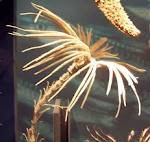Order1:-Phanerozonia
1) Arms are provided with two rows of conspicuous marginal plates.
2) Oral plates are infra-marginal and aboral plates are supra-marginal.
3) Pedicellariae are alveolar or sessile type.
4) Pedia or tube feet are arranged in two rows.
5) Mouth frame is well developed and adambulacral type.
Order2:- Spinulosa
1) Arms are generally without conspicuous marginal types.
2) They have infra-marginal oral plates and supra- marginal aboral plates.
3) They have alveolar or sessile type of pedicellariae.
4) They have tube feet which are arranged in two rows.
5) They have well developed mouth frame and adambuacral type.
Order3:- Forcipulata
1) They have marginal plates which are inconspicuous or absent.
2) They have aboral skeleton which is mostly reticulate with conspicuous spines.
3) They have tube feet which are arranged in four rows and provided with suckers.
4) They have Papulae on both surface.
5) They have mouth frame of ambulacral type.
Orders of class Echinoidea
Order1:- Lepidocentroida
1) Test flexible with overlapping or separated plates.
2) Ambulacral plates continue up to mouth lip
Order2:- cidaroidea
1) Test is rigid and globular.
2) Two rows of long narrow ambulacral plates and two rows of inter ambulacral plates.
3) Ambulacral and inter ambulacral plates continue up to mouth lip.
4) C
5) Five bushy Stewart’s organs are present appended to the lantern.
Order3:- Aulodonta
1) Test is symmetrical and globular.
2) Test composed of two rows each in a ambulacral and inter ambulacral plates.
3) Ambulacral and inter ambulacral plates continue up to mouth lip.
4) Gills and sphaeridia are present.
5) Teeth of aristotle’s lantern are devoid of keel.
Order4:- camaradonata
1) Test is rigid and rarely oval.
2) Epiphyses of lantern are enlarged and meeting above the pyramids.
3) Teeth are keeled.
4) All the four types of pedicellariae are present.
Order5:- Clypeastroida
1) Test is flattened , oval or rounded in shape covered with small spines.
2) Mouth and apical system are usually central and oral in position.
3) Aboral ambulacral areas petaloid.
4) Aristotle’s lantern is present.
5) Gills are absent
Order6:- Spatangoida
1) Test is oval or heart shaped.
2) Four aboral ambulacral areas petaloid, fifth not petalloid.
3) Aristotle’s lantern absent
4) Gills absent.
















